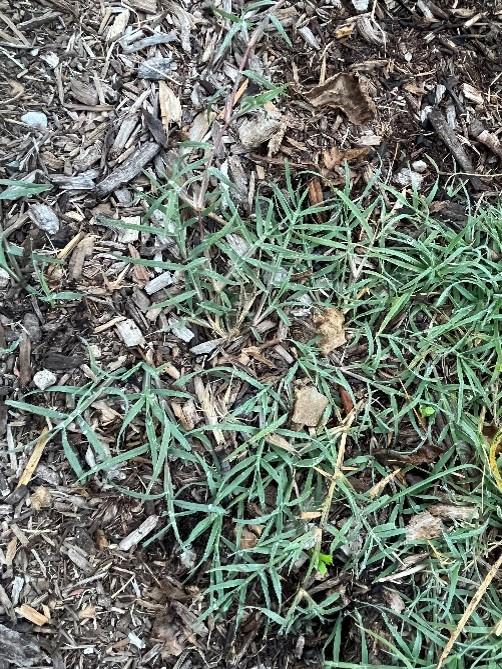Unlike the other plants in my garden, turf grass has always struggled to get my attention. Compared to my knowledge of food crops and herbaceous perennials, I know next to nothing about turf grasses…and I would prefer to keep it that way. Some would find that hard to believe, but it’s true. Identifying turf is like complex math to me…I can do it, but I don’t want to.
When I look at turf, my eyes only see two types: good turf and bad turf.
- Good turf to me is any grass or grass mix that stays out of flower beds and provides a good surface for barefoot walking.
- Bad turf includes the types that for whatever reason finds my flower beds highly attractive for colonization and in no way invites you to drop down and roll around.
Unfortunately, certain “weedy” grasses are harder to control than others, making identification a necessary step in the control process.
Bermudagrass - Weed or grass?
Bermudagrass (Cynodon dactylon) is an interesting warm-season perennial grass in that it can be a desirable turf type for some and a horrible weed for others.
The transition zone from the use of cool season turf grasses to warm season turf grasses starts “roughly” at St Louis, meaning bermudagrass and other warm season grasses become more prominent as you move south and cool season grasses like fescue predominate as you move north. You can imagine this transition zone has resulted in squabbles between neighbors where one neighbor purposely plants bermudagrass as a desirable turf and the other neighbor sees it as a weed when it creeps into their fescue lawn.
Bermudagrass vs nimblewill
Bermudagrass is a common warm-season turf grass used in more southern locations, yet is considered a lawn weed in other turf types, especially in more northerly locations. To this turf neophyte, bermudagrass looks rather like nimblewill (Muhlenbergia schreberi). Nimblewill is also a warm-season perennial grass considered weedy when it invades other turf types in our area, but unlike bermudagrass, nimblewill is native to much of the U.S.
Does identification matter in terms of control if they are both warm-season perennial grasses? Sometimes, yes.
While both are impossible to selectively control without commercially labeled herbicides, nimblewill can be controlled with a much less expensive selective herbicide than the selective herbicide option for bermudagrass. When I use the term selective control in this case, I mean the ability to broadcast spray the entire lawn and selectively kill the bermudagrass or nimblewill without harming the rest of the desirable turfgrass.
Naturally, I have Bermudagrass. I know this because one of the key differences between the two is their ligules. Bermudagrass has a hairy ligule and nimblewill has a membranous ligule, but you will need a microscope and tweezers to see clearly either.
Because of the upfront costs associated with buying the commercially packaged selective herbicides (not packaged or sold for home use), cost of control is now a major consideration. Since I am not dealing with a PGA golf course fairway, I may be better off applying a much cheaper non-selective herbicide like glyphosate to kill off the entire affected area, then reseeding.
It sure would be nice to know what kind of “good’ grass I had for matching purposes, but that would require me to know something else about turf. No wonder I don’t like turf!
MEET THE AUTHOR
Elizabeth Wahle is a Commercial Agriculture Educator with University of Illinois Extension, and her major focus and expertise is the Illinois commercial specialty crop industry. Elizabeth provides program leadership for a number of program events for commercial growers including From Food to Flowers, the Southern Illinois Fruit and Vegetable School and the Gateway Green Industry Conference. In addition to her statewide duties, Elizabeth also provides consumer horticultural support to University of Illinois Extension in Madison, Monroe, and St Clair counties. Marrying the two responsibilities, Elizabeth is dedicated to creating educational resources that build and sustain viable food webs and ecosystems.
